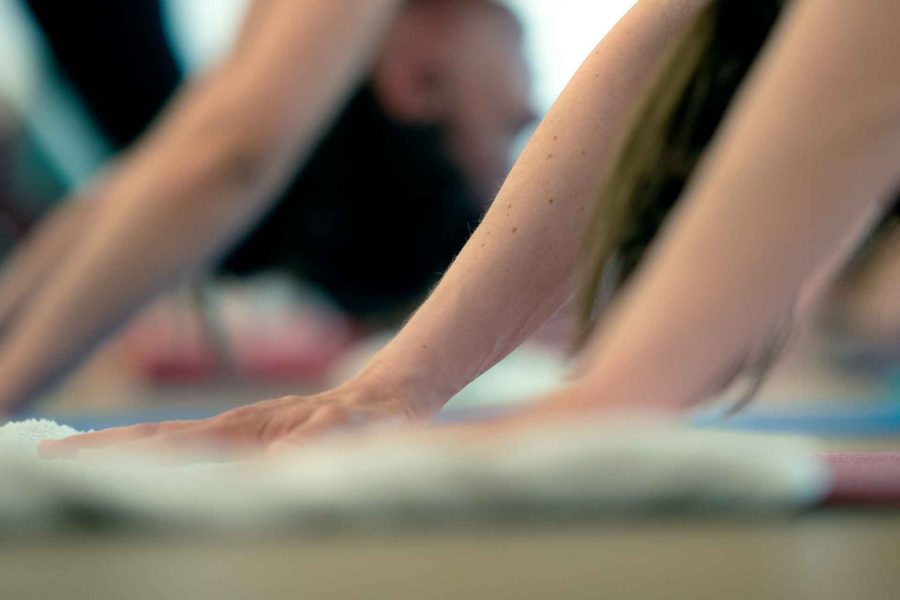
It’s part of every yoga class and the downward facing dog has successfully sniffed its way into many fitness lessons. You have done it at least once too, haven’t you? The famous downward facing dog. It is so well known that most teachers don’t even bother to explain its mechanics and its purpose.
Instead of clear instruction, we get much ado about details like: how to get the heels to the ground or trying to straighten the knees at any cost. You have heard it all…bend the elbows, straighten the elbows, relax the neck – no, keep it straight – no, look at your navel, close your feet – no, keep them apart…human’s best friend is mutating into a bewildered buddy that we habitually call each day but never really begin a conversation with because we are full of chatter of the voices around us. Poor doggy. It’s time to look deeply into our furry friend’s eyes.
…human’s best friend is mutating into a bewildered buddy that we habitually call each day but never really begin a conversation with because we are full of chatter of the voices around us. Poor doggy.
In the abundance of dos and don’ts is there common ground? Let’s be clear, neither straight legs nor heels on the mat are significant ingredients to the posture. So, what is the essence of the down dog?
Human’s best friend
This nickname is wonderfully appropriate. What the dog is capable of giving us humans can actually compare to a friend – our spine’s best friend to be exact. The down dog is an amazing release in the lower spine by turning around the effect of gravity.
We usually sit, walk or stand and that’s how the lower spine has to bear most of the weight. That is no problem, because it is built stable enough to do this job brilliantly. However, the lower spine needs to get a break every now and then. The doggie gifts the spine with a wonderful release.
So, instead of keeping yourself busy with minor details like straight legs or heels down, focus on creating space in your spine. In fact, bending the knees assists your spine beautifully to be long and spacious. Why? Because the back of the legs are connected to the sit-bones and when you straighten your legs, the pelvis tends to pivot causing the sit-bones to look back (instead of pointing up to the sky) which in turn causes the lower back to round and gone is the much needed release.
If you want to find out what a long spine – as opposed to a round spine – feels like, try the following:
Position yourself like you were about to do the dog, leave your knees on the ground, tuck your toes and bend your knees to your personal maximum sitting back towards your heels. You don’t need to actually sit on your heels, simply bend the knees as much as they feel good. Walk your hands forward and bend down with your upper body and walk, walk, walk your hands forward and stretch your arms and fingers. Your upper body is touching your thighs. Relax your neck, if the forehead is on the ground, leave it there, if not, don’t bother. Pull your shoulders away from the ears and press your hands into the ground. Stay as you are and without lifting your pelvis, pull your sit-bones back and up.
Breathe. Enjoy. Feel your back and your spine. That’s it!
That’s the feeling of the down dog: memorize this long, spacious spine. That is the essence of the down dog! You are doing it. You are enjoying the main benefit of the dog. This can be your down dog for how long you want, any time you want. If you choose to lift your knees, make sure your spine feels the same. Long. Spacious.
If you choose to lift the knees, here is an idea: leave the knees bent. Bent legs make sure your thighs are working, assisting your back to release and giving freedom to the pelvis to let the sit-bones look back and up like a happy puppy looks up at you in hope for a treat.
Soooo…why do some of us straighten the legs?
For one simple reason: If your legs don’t feel any stretch with bent knees, you can find a stretch by straightening them. The stretch on the back of the legs is an additional benefit, but it is not the essence of the pose. You can choose if you are happy with the release in your spine or if you want to add a leg stretch – choose freely like you do when you order a frozen yoghurt. The essence is to get the yoghurt (the release in the spine) and if you like, you can sprinkle some strawberries on top (you can add a stretch in your legs). It is a matter of personal taste. If you do straigthen your legs, make sure to keep the thighs engaged – the pelvis and back need their assistance.
You don’t like strawberries? Fine! Throw some nuts on your yoghurt – or in our dog world, you can gently pull your heels towards the ground to stretch and release tension from your calves.
Speaking of heels, why is there so much fuzz about putting your heels firmly on the ground? I have absolutely no idea. I don’t know who came up with this.
It does make sense to pull the heels towards the ground gently to create a lovely stretch in the calves. Doing so, some heels will automatically touch the ground and some won’t. Sure, it has something to do with how much tension to we hold on to in the calves and around the ankles, but the main two things here are not flexibility that increases with stretching, but alignment and bone structure.
First, let’s look at alignment: the smaller the distance between hands and feet, the lower your heels will be. Second, bone structure: We all are given a natural ability to bend the joint (the ankle) and this has nothing to do with the sort of flexibility that can be trained by stretching for ages. This is how your beautiful body is. You can’t – and I hope you have no desire to – shape your bones in a way that fits someone else’s idea of this dog posture. Let your ankles be what they are: The magnificent link between legs and feet, being able to bend and extend, to circle and move your feet in figure eight loops.
But, why a dog?
With the pose we imitate a dog that has just woken up from a lovely nap and begins to stretch thoroughly. Pushing the front legs forward and the butt back and up, they demonstrate how to create this stretch. However, have you ever wondered why it is called downward facing dog? Why not downward facing tiger? Tigers stretch in the same way as dogs do.
So, why a dog?
I think there are two reasons: Firstly, a dog is always around us humans even if we don’t have one of our own. We can watch dogs doing the down dog and learn from them how it’s done. They do exactly what we are supposed to do; they stretch the spine. Unlike us humans, they don’t overcomplicate this. They don’t seem to worry much about straight hind legs or if the neighbor dog is more flexible than they are themselves. All they do is enjoy their stretch. I think we can really be inspired by them. Just get up and stretch. And don’t make such a big deal of things that aren’t important.
Plus, enjoy!
Which brings us to the second reason why I believe it is called dog: A dog is trustworthy and playful. The dog reminds us to treat ourselves in a way that our body can trust us with its wellbeing. The body knows that we don’t force it into something that doesn’t feel good or disrespects its natural, unique construction. With this trust, we create the basis for playfulness. We can only play and relax and explore when we feel like we are in good hands. So, you are in your own good hands. Treat yourself with kindness and playfulness. Have fun like a puppy! Be playful each time you do your downward facing dog. Never try to copy what you did yesterday, because today your body is different. Also, don’t copy someone else, because the world needs YOU. You as you are.
You know, whenever I teach this dog stretch, I can hear all the spines in the class taking a sigh of relief. It feels like a wave going through all of us. No struggle. No competition. But instead, everyone in class is looking different in their pose, some with knees on the ground, some with bent knees, some with their elbows on the ground, some wiggling softly from side to side, some being completely still. They all choose their dog for today, all I do is suggest different things to offer everyone an idea of how their dog could feel great. Every option is equal. There is no beginner option. And no advanced version. A stretch is a stretch, not a competition. Everyone makes a conscious choice based on a direct feedback from the body. Everyone is different and unique. That’s why there are so many different suggestions of how to do the doggy: that everyone finds their own thing.
There have to be as many different kinds of downward facing dogs as there are people doing it. It’s only logical.
In a room, where there are unique doggies, stretching and enjoying, we are all connected by what I think is the most important aspect of the doggy: We are glowing from the inside, because we are so happy that we are doing it our way and love ourselves the way we are. Like each puppy has its own cuteness, we all allow our unique dog to surface and be our spine’s best friend. This is pure beauty.
Comment below and share your views, worries, stories, positivity and thoughts with me. Or send me a DM on Instagram @suzannefreiherz
Photo by Tom Freiherz.

